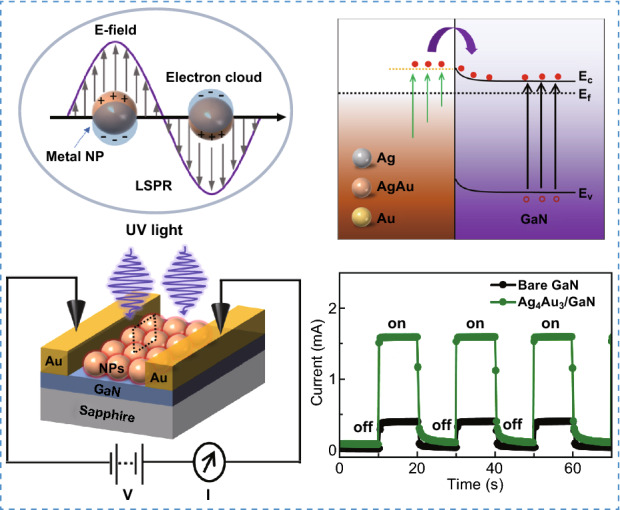- Record: found
- Abstract: found
- Article: found
Improved Photoresponse of UV Photodetectors by the Incorporation of Plasmonic Nanoparticles on GaN Through the Resonant Coupling of Localized Surface Plasmon Resonance

Read this article at
Highlights
-
Enhancement of UV photoresponse by the incorporation of various plasmonic nanoparticles in the detector architecture.
-
Detailed explanation for the photocurrent enhancement mechanism by the finite-difference time domain (FDTD) simulation and strong plasmon absorption.
-
Systematic comparison and demonstration of the superior photoresponse of homogeneously alloyed AgAu nanoparticles as compared to the monometallic nanoparticles.
Abstract
Very small metallic nanostructures, i.e., plasmonic nanoparticles (NPs), can demonstrate the localized surface plasmon resonance (LSPR) effect, a characteristic of the strong light absorption, scattering and localized electromagnetic field via the collective oscillation of surface electrons upon on the excitation by the incident photons. The LSPR of plasmonic NPs can significantly improve the photoresponse of the photodetectors. In this work, significantly enhanced photoresponse of UV photodetectors is demonstrated by the incorporation of various plasmonic NPs in the detector architecture. Various size and elemental composition of monometallic Ag and Au NPs, as well as bimetallic alloy AgAu NPs, are fabricated on GaN (0001) by the solid-state dewetting approach. The photoresponse of various NPs are tailored based on the geometric and elemental evolution of NPs, resulting in the highly enhanced photoresponsivity of 112 A W −1, detectivity of 2.4 × 10 12 Jones and external quantum efficiency of 3.6 × 10 4% with the high Ag percentage of AgAu alloy NPs at a low bias of 0.1 V. The AgAu alloy NP detector also demonstrates a fast photoresponse with the relatively short rise and fall time of less than 160 and 630 ms, respectively. The improved photoresponse with the AgAu alloy NPs is correlated with the simultaneous effect of strong plasmon absorption and scattering, increased injection of hot electrons into the GaN conduction band and reduced barrier height at the alloy NPs/GaN interface.

Related collections
Most cited references59
- Record: found
- Abstract: not found
- Article: not found
The Optical Properties of Metal Nanoparticles: The Influence of Size, Shape, and Dielectric Environment
- Record: found
- Abstract: found
- Article: not found
Nonradiative Plasmon Decay and Hot Carrier Dynamics: Effects of Phonons, Surfaces, and Geometry.
- Record: found
- Abstract: not found
- Article: not found